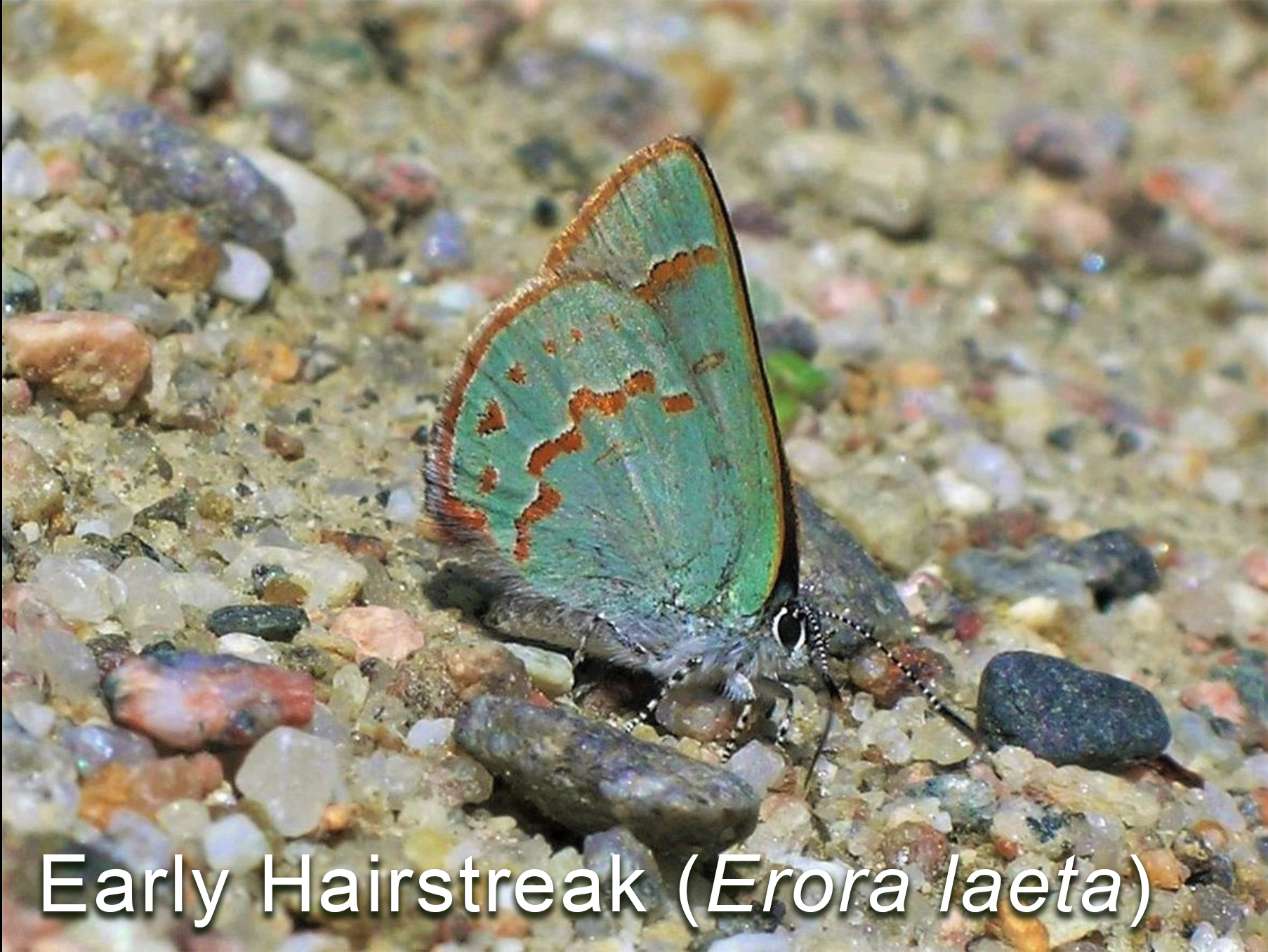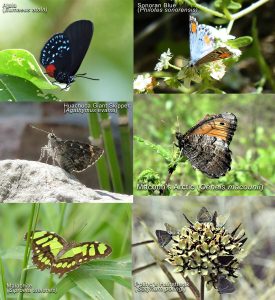By Peter Hall, scientific and administrative advisor to eButterfly
For every butterflier, I would be willing to bet that over the years, when out on field trips, you have had some ‘special’ butterflies in mind that you hope to come across – in other words, ‘Holy Grails’ or, simply, grails.
A definition of ‘Holy Grail’ – aside from its historical, religious context – is something that you want very much, but it is challenging to find or achieve. Just about every human endeavour has had its grails. For medicine, it could be the cure for cancer; for art, the discovery of a lost Da Vinci; for sports, the first four-minute mile; for birding, an Ivory-billed Woodpecker or, more realistically, a Golden-cheeked Warbler. The ideal is that with research, steady effort and a little bit of luck, they could be achieved.
The concept of grails for butterfly viewing can be a useful one. Bob Pyle, in his classic Mariposa Road: the first big butterfly year, decided to take the approach of “…going for grails in the faith that the commoner species would show up along the way.” It panned out for him as he found that while crisscrossing the United States to find 30 of his 40 or so grails, he came across a total of 478 butterfly species. I realized in reading the book, this is precisely the approach I have taken for years.
So what constitutes a grail butterfly species? Actually, it’s not an easy concept to pin down. I’ve identified at least ten factors that came into play as I listed my own particular grails over the years for North America north of the Mexican border (some of these even pop up in my dreams).
Lifers can be an essential aspect of any butterfly search. The first time you ever see any species makes it unique. Related to that can be the rarity of the species. The rarer something is, the more difficult it will be to find and, even if widespread, it can be seldom seen.
Some species are simply elusive. Even in the appropriate habitat and conditions, they just are not often seen. Some are ephemeral in nature – they are not seen for years, show up in numbers at a location and then disappear again for years. Many species are only found in a particular region of the continent – for instance, only in the arctic, mountain and desert habitats, or particularly along the southern US border. The difficulty of the terrain can also add to the allure. The conditions can make access to view the species very difficult– think of alpine tundra or a remote bog.
As we are all humans, the attractiveness of a species can definitely add to the allure. The large size and/or bright colours often move a species up the grail list.
The larval foodplants can be another essential aspect. Many rare butterfly species are often associated with a single, sometimes unusual foodplant. Searching out the foodplant may be the likeliest way to come across the grail butterfly.
Some species tend to be grails because mythology builds up around them. Almost everyone would agree, and indeed, the butterfly literature reinforces this, that the Early Hairstreak of eastern North American woodlands is one of these. I particularly like it’s a very appropriate French name, Lutin mysterieux, translated into English as the mysterious elfin. As a youngster in Ontario, it was my number one grail. They are associated with stands of mature American Beech and, outside of a few known sites, are rarely found. Even after seeing many over the years, I still seek it out and am thrilled to encounter it.
As just discussed, a grail species is a very personal concept and can and will change over time. Butterflies I really wanted to find as a kid can be old hat as you get older. One such was the Giant Swallowtail, which was not known from my home territory in Ontario. It has now become common where I live as its range extends further north. The Giant Swallowtail is no longer a personal grail, but it will never become a ‘just a…’ species for me. You have to be careful that familiarity does not breed contempt.
There are some species that I would not include on my grail list for two reasons. One, I do not include rare strays as they cannot be expected in a routine field trip in the US or Canada. This is particularly true of those Mexican species not breeding further north than the Mexico-U.S. border and show up only sporadically. My second elimination factor is those species that are so remote, inaccessible or likely extirpated that I have no realistic hope of seeing them. Examples of these species are the high-arctic, very localized Johansen’s Sulphur, the high-mountain, rare Alberta Fritillary and the extirpated Zestos Skipper formerly in Florida.
So, with all the above, what are some of my particular grail species? After about sixty years of butterfly searching, I can divide these into four categories based on my own personal butterflying history. Each has a brief annotation:
- Species generally considered as grails that I caught up to and photographed:
- Short-tailed Swallowtail – Canadian maritime provinces endemic
- Old World Swallowtail – remote northern species with many subspecies, some grails
- Labrador Sulphur – only above timberline in the high arctic and alpine tundra
- Bog Elfin – found in mostly inaccessible bogs in a limited region of the north-east
- Atala – once thought extirpated from extreme southern Florida, now increasing
- Poling’s Hairstreak –restricted range in western Texas and eastern New Mexico
- Early Hairstreak – the southern Appalachians to the Great Lakes region
- Sonoran Blue – tiny, brilliant southern California resident
- Blue Metalmark – a shiny-blue, Rio Grande Valley metalmark
- Banded Patch – one of the least often seen residents of south Texas
- Elf – tiny and sporadic checkerspot in SE Arizona
- Malachite – large, beautiful and rare resident of Florida and southern Texas
- Macoun’s Arctic – widespread Canadian boreal species but often inaccessible
- Apache Skipper – autumn-flyer in scattered mountain locations of south-west US.
- Huachuca Giant-Skipper – all G-Ss are grails, but this has the tiniest range, only in Arizona
- Grails that I saw but never got a photograph (very frustrating):
- Ruby-spotted Swallowtail – large and colourful Lower Rio Grande species
- Rocky Mountain Parnassian – alpine-meadow, large, tail-less, white Swallowtail
- California Dogface – iconic California resident
- Loki Hairstreak – found in only a few locations in southern California
- Xami Hairstreak – searched for in many places in US south-west – saw only once
- Rockslide Checkerspot – a high alpine rarity of the Rockies and central California
- Florida Leafwing and Florida Purplewing – saw both once on the same day, many years ago
- Species in the right habitat at the right time and still missed (bad weather, bad luck):
- Eversmann’s Parnassian – mountain tundra in the north-west
- Bartram’s Hairstreak – a southern Florida endangered species
- Gillette’s Checkerspot – mountain meadows in the Rockies
- Colorado Alpine – limited range specialty of the central Rockies
- Relict Fritillary – same as above
- Colorado Hairstreak – one of the most beautiful hairstreaks of the western mountains
- Some of my future ‘Holy Grails’ awaiting possible trips (my most important list):
- All of those in 3 above
- Schaus’ Swallowtail – highly prized, endangered resident of Florida Keys
- Green Marble – relatively recently named, restricted Alaska-Yukon resident
- Hessel’s Hairstreak – highly localized east coast resident
- Sandia Hairstreak – a copper and green prize from western Texas and New Mexico
- Herme’s Copper – endangered San Diego area species
- Swamp Metalmark – an isolated and disappearing species of US mid-west
- Diana Fritillary – a large, spectacular and declining butterfly of the Appalachians and Ozarks
- Regal Fritillary – mostly gone from the east and falling and localized in the mid-west
- Hoffman’s Checkerspot – a west coast mountain species seldom seen
- Rare Skipper – isolated to a few marshes on the US east coast
- Crystal Skipper – newly identified species of a few barrier islands in North Carolina
There is my top-40 list of grail species that have flown in my imagination throughout my life. One other interesting fact is that of the 23 I have seen, 15 of them I only saw once. That says something about the elusiveness of these species. There are, of course, many more North American butterfly species that would be lifers for me and I would love to find them, but they are not as vivid and elusive in my mind’s eye as the grails above.
A quick plug for eButterfly – by entering your sightings, you have made it much easier for me to plan trips and find suitable locations for many of my grail species.
Many of you will likely agree with some of these grails but also have your own list. I hope some of you will share your grail list with other eButterfly readers.


